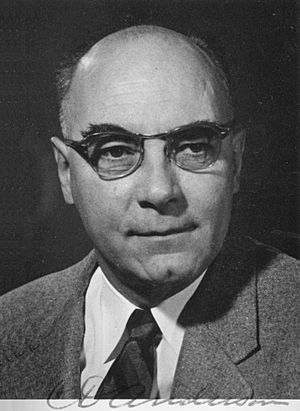Carl David Anderson facts for kids
Quick facts for kids
Carl David Anderson
|
|
|---|---|
 |
|
| Born | September 3, 1905 New York City, New York, U.S.
|
| Died | January 11, 1991 (aged 85) San Marino, California, U.S.
|
| Alma mater | California Institute of Technology (BS, PhD) |
| Known for | Discovery of the positron Discovery of the muon |
| Awards | Nobel Prize in Physics (1936) Elliott Cresson Medal (1937) |
| Scientific career | |
| Fields | Physics |
| Institutions | California Institute of Technology |
| Thesis | Space-distribution of x-ray photoelectrons ejected from the K and L atomic energy-levels (1930) |
| Doctoral advisor | Robert A. Millikan |
| Other academic advisors | William Smythe |
| Doctoral students |
|
| Other notable students | Cinna Lomnitz |
Carl David Anderson (born September 3, 1905 – died January 11, 1991) was an American physicist. He is best known for discovering two tiny particles: the positron in 1932 and the muon in 1936. For finding the positron, he received the 1936 Nobel Prize in Physics.
Contents
Carl Anderson's Life and Discoveries
Carl Anderson was born in New York City. His parents had moved there from Sweden. He studied physics and engineering at the Caltech. He earned his first degree in 1927 and his PhD in 1930.
Finding the Positron
Under the guidance of his professor, Robert A. Millikan, Carl Anderson started studying cosmic rays. Cosmic rays are high-energy particles that come from space. He used a special tool called a cloud chamber. This chamber helps scientists see the paths of tiny particles.
In his cloud chamber photos, Anderson saw some unexpected tracks. These tracks looked like they were made by a particle that had the same mass as an electron. However, this new particle had the opposite electrical charge. Electrons have a negative charge, so this new particle had a positive charge. He called this new particle the "positron."
Anderson announced his discovery in 1932. Other scientists later confirmed it. This discovery was very important because it proved a theory by another physicist named Paul Dirac. Dirac had predicted that such a particle, an "anti-electron," should exist.
Anderson first found positrons in cosmic rays. To get more proof, he used gamma rays. Gamma rays are a type of high-energy light. He shot these gamma rays into different materials. This process created pairs of particles: one positron and one electron.
For his groundbreaking work on the positron, Carl Anderson shared the 1936 Nobel Prize in Physics with Victor Hess. Years later, Anderson said that his discovery was inspired by the work of a classmate, Chung-Yao Chao.
Discovering the Muon
In 1936, Carl Anderson and his student, Seth Neddermeyer, made another big discovery. They found a new subatomic particle called the muon. They found it while studying cosmic rays again.
The muon was much heavier than an electron, about 207 times heavier. But it had the same negative electrical charge and spin as an electron. At first, Anderson and Neddermeyer thought they had found a different particle called a pion. A pion had been predicted by a scientist named Hideki Yukawa.
When it became clear that the particle they found was not the pion, another physicist, I. I. Rabi, famously asked, "Who ordered that?" He was puzzled because the muon didn't seem to fit into the known ideas about particle physics at the time.
The muon was one of the first of many new subatomic particles that scientists found. These discoveries often confused scientists at first, as they tried to understand how all these new particles fit together.
Later Career and Legacy
Carl Anderson spent his entire career at Caltech. During World War II, he even worked on rocket research there. He was recognized for his contributions to science. He became a Fellow of the American Academy of Arts and Sciences in 1950. He also received the Golden Plate Award in 1975.
Carl Anderson passed away on January 11, 1991. He was buried in the Forest Lawn, Hollywood Hills Cemetery in Los Angeles, California. His wife, Lorraine, had passed away in 1984.
See also
 In Spanish: Carl David Anderson para niños
In Spanish: Carl David Anderson para niños

